Analysis of HR Development: TESCO's Approach to Employee Engagement
VerifiedAdded on 2020/07/22
|14
|4432
|60
Report
AI Summary
This report provides a comprehensive analysis of HR development within the context of TESCO, a UK-based retail store. It begins by defining the essential knowledge, skills, and behaviors required by HR professionals, emphasizing the importance of roles like consultant, policy formulator, and negotiator. The report then examines a personal skills audit of an HR manager, Jane Cambridge, highlighting her strengths (IT skills, knowledge of employment laws) and weaknesses (training delivery, database proficiency) and outlining a development plan to address these gaps. Furthermore, it analyzes the differences between individual and organizational learning, emphasizing their interconnectedness for continuous growth. The report also explores how high-performance working contributes to employee engagement and evaluates different approaches to performance management, concluding with insights into optimizing HR practices for enhanced business performance.
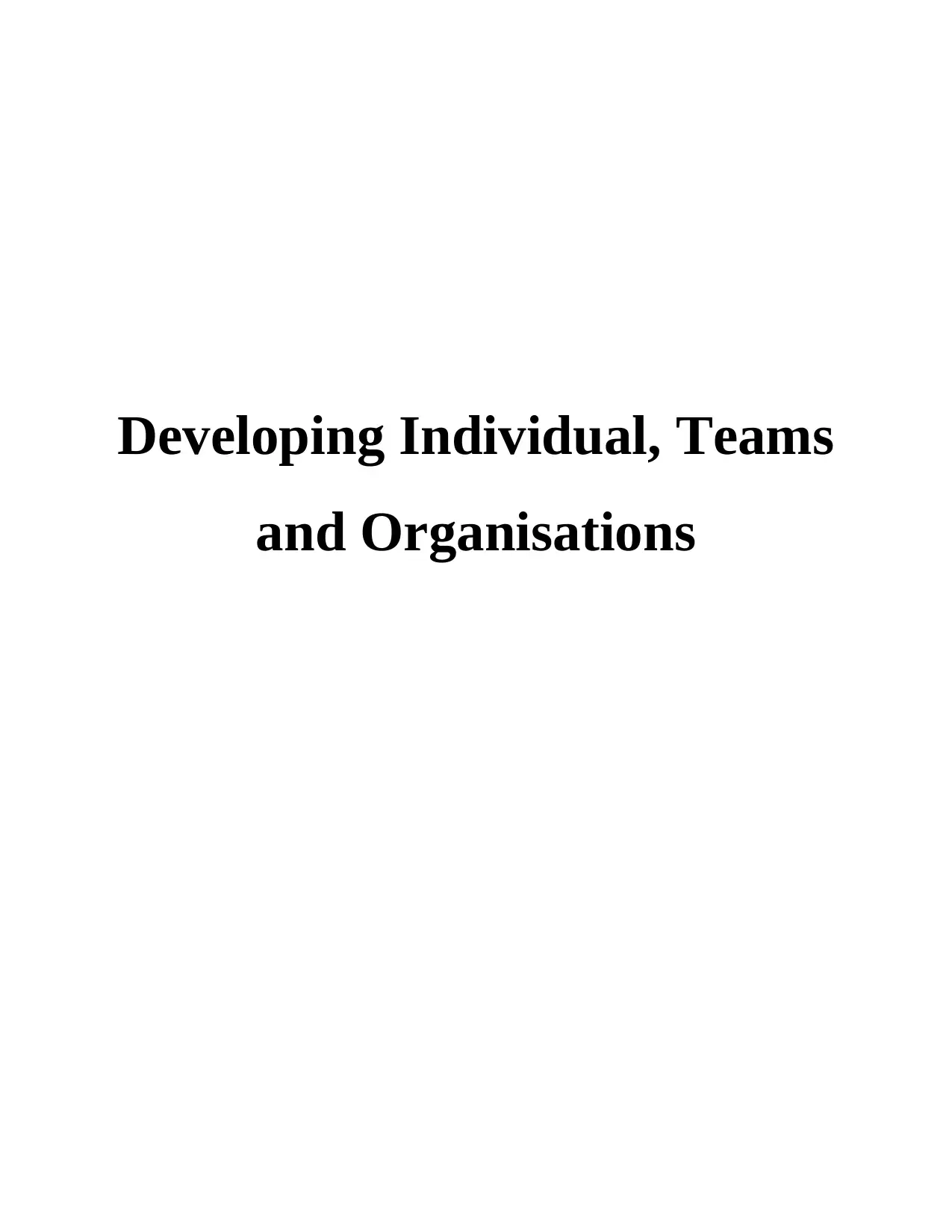
Developing Individual, Teams
and Organisations
and Organisations
Paraphrase This Document
Need a fresh take? Get an instant paraphrase of this document with our AI Paraphraser
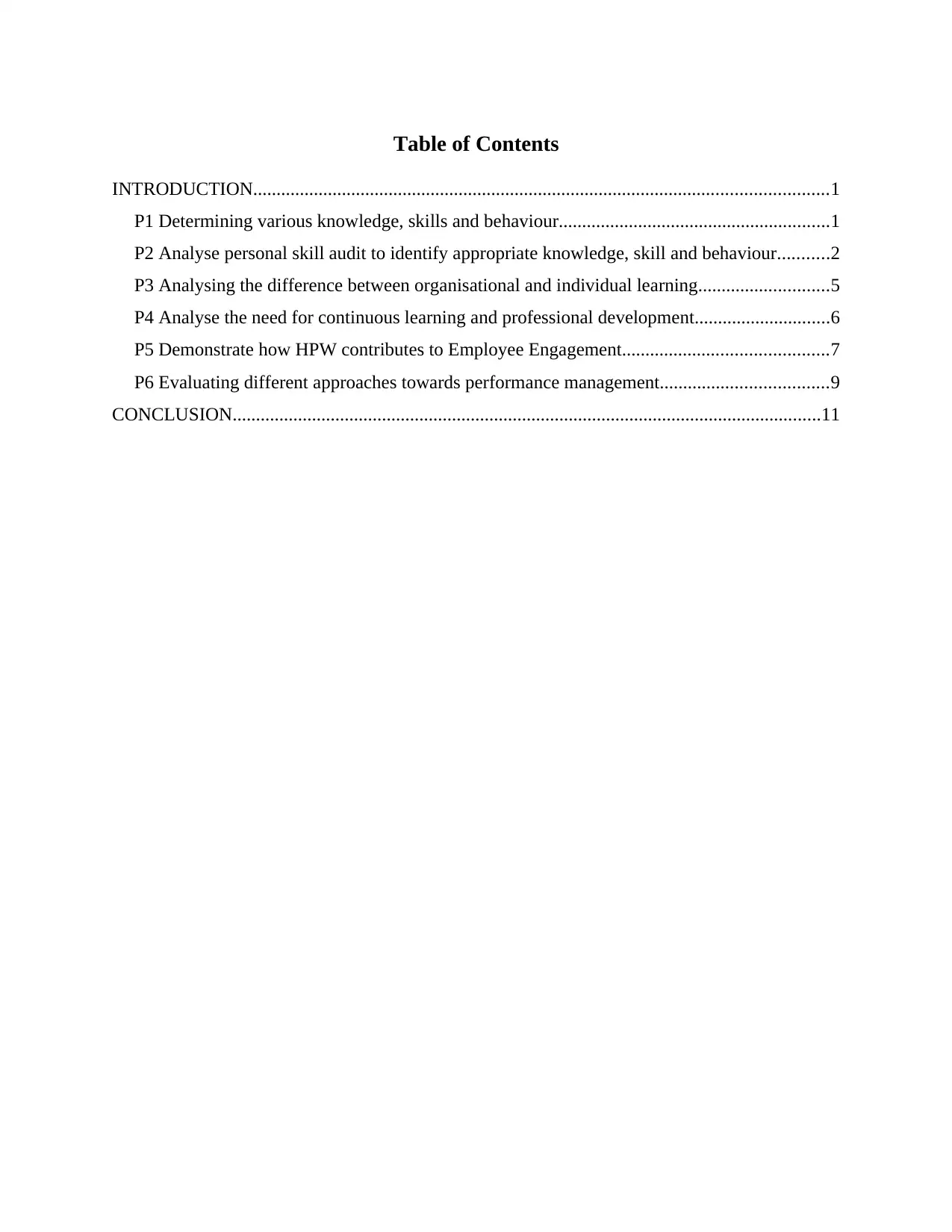
Table of Contents
INTRODUCTION...........................................................................................................................1
P1 Determining various knowledge, skills and behaviour..........................................................1
P2 Analyse personal skill audit to identify appropriate knowledge, skill and behaviour...........2
P3 Analysing the difference between organisational and individual learning............................5
P4 Analyse the need for continuous learning and professional development.............................6
P5 Demonstrate how HPW contributes to Employee Engagement............................................7
P6 Evaluating different approaches towards performance management....................................9
CONCLUSION..............................................................................................................................11
INTRODUCTION...........................................................................................................................1
P1 Determining various knowledge, skills and behaviour..........................................................1
P2 Analyse personal skill audit to identify appropriate knowledge, skill and behaviour...........2
P3 Analysing the difference between organisational and individual learning............................5
P4 Analyse the need for continuous learning and professional development.............................6
P5 Demonstrate how HPW contributes to Employee Engagement............................................7
P6 Evaluating different approaches towards performance management....................................9
CONCLUSION..............................................................................................................................11
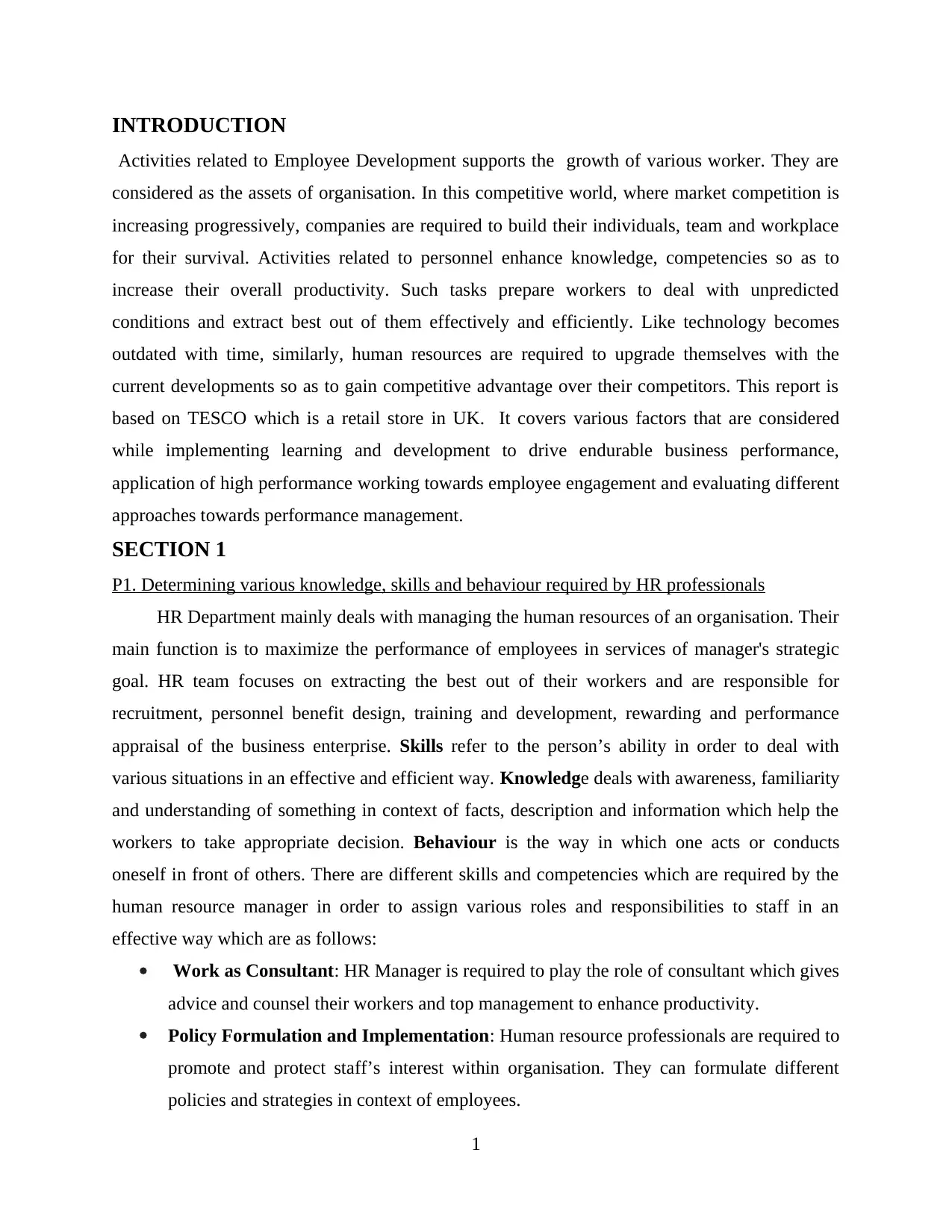
INTRODUCTION
Activities related to Employee Development supports the growth of various worker. They are
considered as the assets of organisation. In this competitive world, where market competition is
increasing progressively, companies are required to build their individuals, team and workplace
for their survival. Activities related to personnel enhance knowledge, competencies so as to
increase their overall productivity. Such tasks prepare workers to deal with unpredicted
conditions and extract best out of them effectively and efficiently. Like technology becomes
outdated with time, similarly, human resources are required to upgrade themselves with the
current developments so as to gain competitive advantage over their competitors. This report is
based on TESCO which is a retail store in UK. It covers various factors that are considered
while implementing learning and development to drive endurable business performance,
application of high performance working towards employee engagement and evaluating different
approaches towards performance management.
SECTION 1
P1. Determining various knowledge, skills and behaviour required by HR professionals
HR Department mainly deals with managing the human resources of an organisation. Their
main function is to maximize the performance of employees in services of manager's strategic
goal. HR team focuses on extracting the best out of their workers and are responsible for
recruitment, personnel benefit design, training and development, rewarding and performance
appraisal of the business enterprise. Skills refer to the person’s ability in order to deal with
various situations in an effective and efficient way. Knowledge deals with awareness, familiarity
and understanding of something in context of facts, description and information which help the
workers to take appropriate decision. Behaviour is the way in which one acts or conducts
oneself in front of others. There are different skills and competencies which are required by the
human resource manager in order to assign various roles and responsibilities to staff in an
effective way which are as follows:
Work as Consultant: HR Manager is required to play the role of consultant which gives
advice and counsel their workers and top management to enhance productivity.
Policy Formulation and Implementation: Human resource professionals are required to
promote and protect staff’s interest within organisation. They can formulate different
policies and strategies in context of employees.
1
Activities related to Employee Development supports the growth of various worker. They are
considered as the assets of organisation. In this competitive world, where market competition is
increasing progressively, companies are required to build their individuals, team and workplace
for their survival. Activities related to personnel enhance knowledge, competencies so as to
increase their overall productivity. Such tasks prepare workers to deal with unpredicted
conditions and extract best out of them effectively and efficiently. Like technology becomes
outdated with time, similarly, human resources are required to upgrade themselves with the
current developments so as to gain competitive advantage over their competitors. This report is
based on TESCO which is a retail store in UK. It covers various factors that are considered
while implementing learning and development to drive endurable business performance,
application of high performance working towards employee engagement and evaluating different
approaches towards performance management.
SECTION 1
P1. Determining various knowledge, skills and behaviour required by HR professionals
HR Department mainly deals with managing the human resources of an organisation. Their
main function is to maximize the performance of employees in services of manager's strategic
goal. HR team focuses on extracting the best out of their workers and are responsible for
recruitment, personnel benefit design, training and development, rewarding and performance
appraisal of the business enterprise. Skills refer to the person’s ability in order to deal with
various situations in an effective and efficient way. Knowledge deals with awareness, familiarity
and understanding of something in context of facts, description and information which help the
workers to take appropriate decision. Behaviour is the way in which one acts or conducts
oneself in front of others. There are different skills and competencies which are required by the
human resource manager in order to assign various roles and responsibilities to staff in an
effective way which are as follows:
Work as Consultant: HR Manager is required to play the role of consultant which gives
advice and counsel their workers and top management to enhance productivity.
Policy Formulation and Implementation: Human resource professionals are required to
promote and protect staff’s interest within organisation. They can formulate different
policies and strategies in context of employees.
1
⊘ This is a preview!⊘
Do you want full access?
Subscribe today to unlock all pages.

Trusted by 1+ million students worldwide
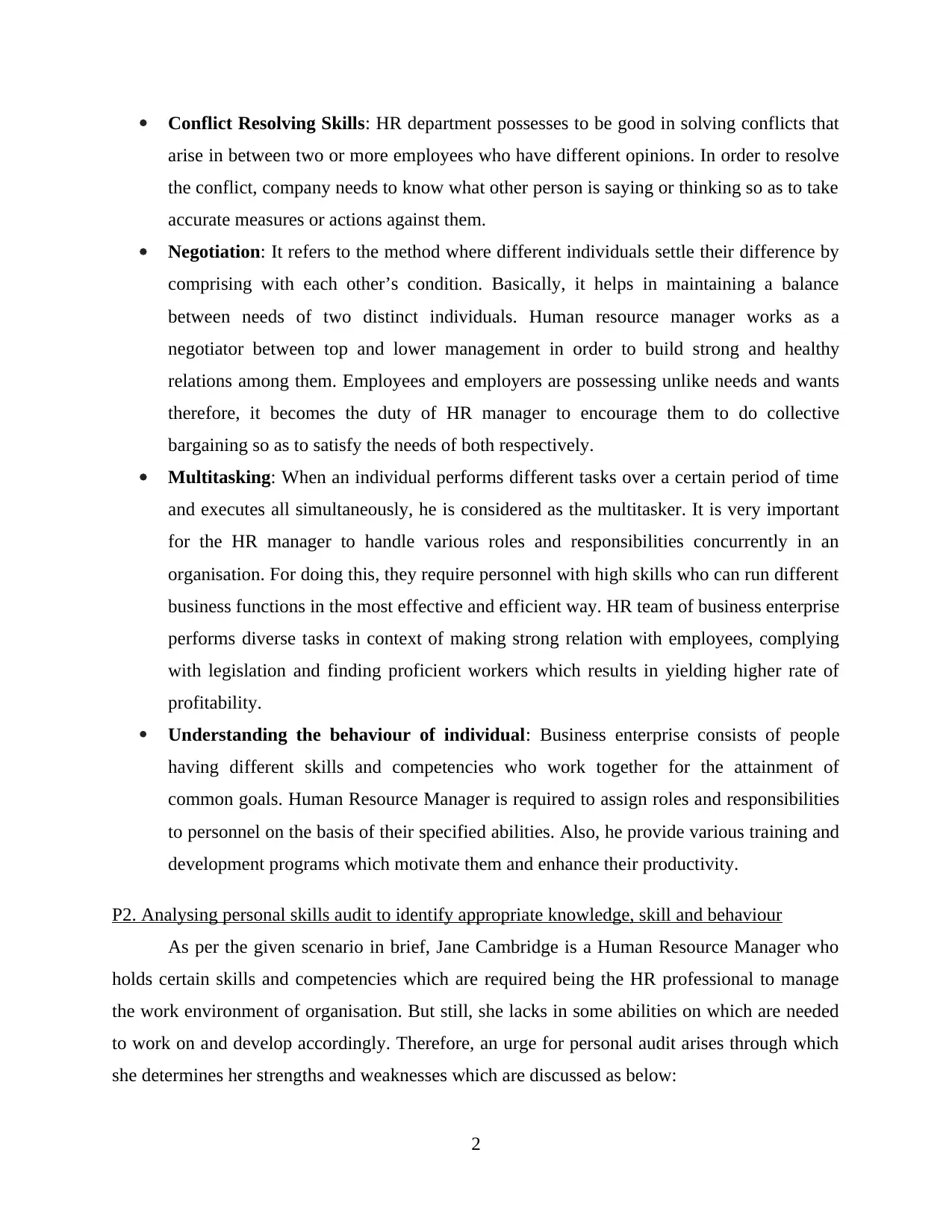
Conflict Resolving Skills: HR department possesses to be good in solving conflicts that
arise in between two or more employees who have different opinions. In order to resolve
the conflict, company needs to know what other person is saying or thinking so as to take
accurate measures or actions against them.
Negotiation: It refers to the method where different individuals settle their difference by
comprising with each other’s condition. Basically, it helps in maintaining a balance
between needs of two distinct individuals. Human resource manager works as a
negotiator between top and lower management in order to build strong and healthy
relations among them. Employees and employers are possessing unlike needs and wants
therefore, it becomes the duty of HR manager to encourage them to do collective
bargaining so as to satisfy the needs of both respectively.
Multitasking: When an individual performs different tasks over a certain period of time
and executes all simultaneously, he is considered as the multitasker. It is very important
for the HR manager to handle various roles and responsibilities concurrently in an
organisation. For doing this, they require personnel with high skills who can run different
business functions in the most effective and efficient way. HR team of business enterprise
performs diverse tasks in context of making strong relation with employees, complying
with legislation and finding proficient workers which results in yielding higher rate of
profitability.
Understanding the behaviour of individual: Business enterprise consists of people
having different skills and competencies who work together for the attainment of
common goals. Human Resource Manager is required to assign roles and responsibilities
to personnel on the basis of their specified abilities. Also, he provide various training and
development programs which motivate them and enhance their productivity.
P2. Analysing personal skills audit to identify appropriate knowledge, skill and behaviour
As per the given scenario in brief, Jane Cambridge is a Human Resource Manager who
holds certain skills and competencies which are required being the HR professional to manage
the work environment of organisation. But still, she lacks in some abilities on which are needed
to work on and develop accordingly. Therefore, an urge for personal audit arises through which
she determines her strengths and weaknesses which are discussed as below:
2
arise in between two or more employees who have different opinions. In order to resolve
the conflict, company needs to know what other person is saying or thinking so as to take
accurate measures or actions against them.
Negotiation: It refers to the method where different individuals settle their difference by
comprising with each other’s condition. Basically, it helps in maintaining a balance
between needs of two distinct individuals. Human resource manager works as a
negotiator between top and lower management in order to build strong and healthy
relations among them. Employees and employers are possessing unlike needs and wants
therefore, it becomes the duty of HR manager to encourage them to do collective
bargaining so as to satisfy the needs of both respectively.
Multitasking: When an individual performs different tasks over a certain period of time
and executes all simultaneously, he is considered as the multitasker. It is very important
for the HR manager to handle various roles and responsibilities concurrently in an
organisation. For doing this, they require personnel with high skills who can run different
business functions in the most effective and efficient way. HR team of business enterprise
performs diverse tasks in context of making strong relation with employees, complying
with legislation and finding proficient workers which results in yielding higher rate of
profitability.
Understanding the behaviour of individual: Business enterprise consists of people
having different skills and competencies who work together for the attainment of
common goals. Human Resource Manager is required to assign roles and responsibilities
to personnel on the basis of their specified abilities. Also, he provide various training and
development programs which motivate them and enhance their productivity.
P2. Analysing personal skills audit to identify appropriate knowledge, skill and behaviour
As per the given scenario in brief, Jane Cambridge is a Human Resource Manager who
holds certain skills and competencies which are required being the HR professional to manage
the work environment of organisation. But still, she lacks in some abilities on which are needed
to work on and develop accordingly. Therefore, an urge for personal audit arises through which
she determines her strengths and weaknesses which are discussed as below:
2
Paraphrase This Document
Need a fresh take? Get an instant paraphrase of this document with our AI Paraphraser
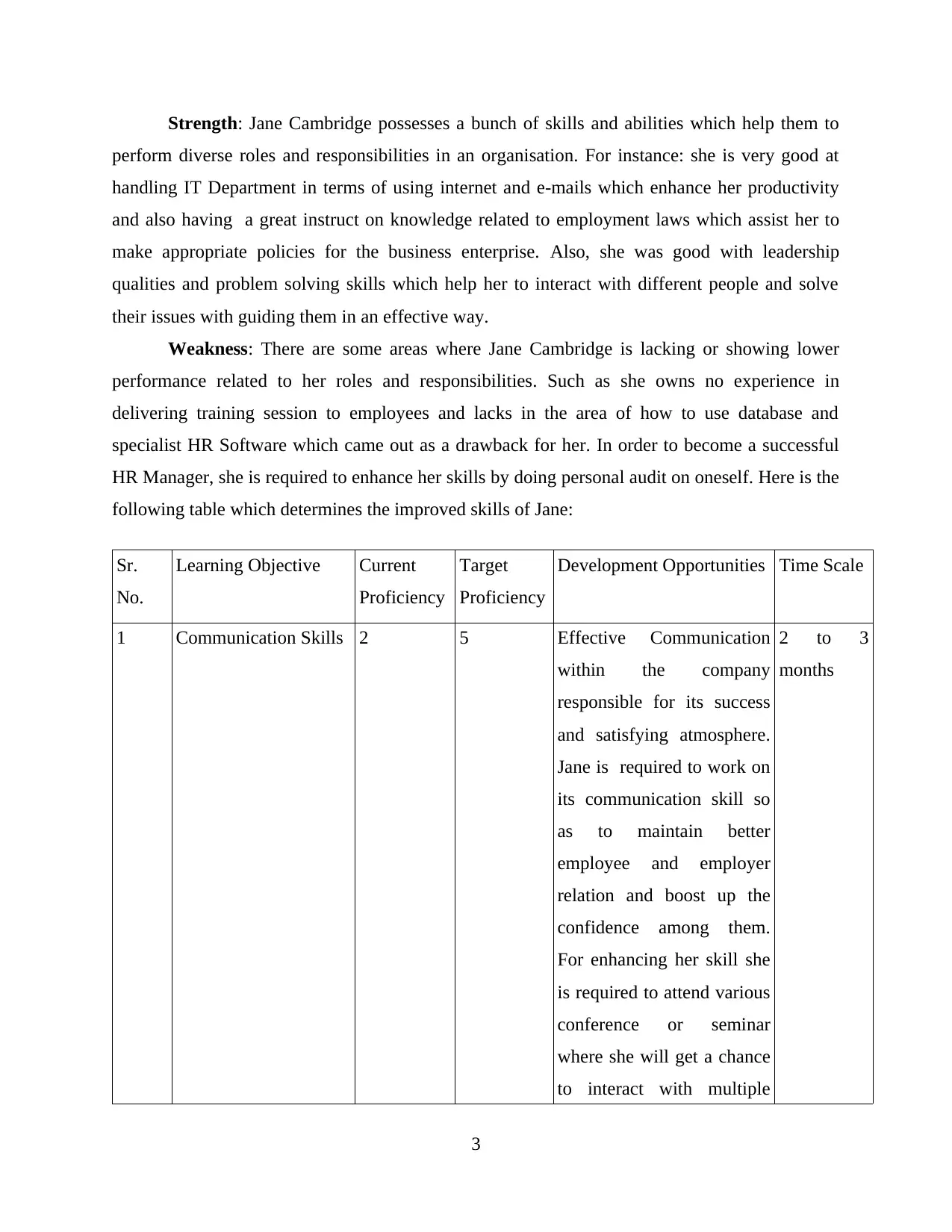
Strength: Jane Cambridge possesses a bunch of skills and abilities which help them to
perform diverse roles and responsibilities in an organisation. For instance: she is very good at
handling IT Department in terms of using internet and e-mails which enhance her productivity
and also having a great instruct on knowledge related to employment laws which assist her to
make appropriate policies for the business enterprise. Also, she was good with leadership
qualities and problem solving skills which help her to interact with different people and solve
their issues with guiding them in an effective way.
Weakness: There are some areas where Jane Cambridge is lacking or showing lower
performance related to her roles and responsibilities. Such as she owns no experience in
delivering training session to employees and lacks in the area of how to use database and
specialist HR Software which came out as a drawback for her. In order to become a successful
HR Manager, she is required to enhance her skills by doing personal audit on oneself. Here is the
following table which determines the improved skills of Jane:
Sr.
No.
Learning Objective Current
Proficiency
Target
Proficiency
Development Opportunities Time Scale
1 Communication Skills 2 5 Effective Communication
within the company
responsible for its success
and satisfying atmosphere.
Jane is required to work on
its communication skill so
as to maintain better
employee and employer
relation and boost up the
confidence among them.
For enhancing her skill she
is required to attend various
conference or seminar
where she will get a chance
to interact with multiple
2 to 3
months
3
perform diverse roles and responsibilities in an organisation. For instance: she is very good at
handling IT Department in terms of using internet and e-mails which enhance her productivity
and also having a great instruct on knowledge related to employment laws which assist her to
make appropriate policies for the business enterprise. Also, she was good with leadership
qualities and problem solving skills which help her to interact with different people and solve
their issues with guiding them in an effective way.
Weakness: There are some areas where Jane Cambridge is lacking or showing lower
performance related to her roles and responsibilities. Such as she owns no experience in
delivering training session to employees and lacks in the area of how to use database and
specialist HR Software which came out as a drawback for her. In order to become a successful
HR Manager, she is required to enhance her skills by doing personal audit on oneself. Here is the
following table which determines the improved skills of Jane:
Sr.
No.
Learning Objective Current
Proficiency
Target
Proficiency
Development Opportunities Time Scale
1 Communication Skills 2 5 Effective Communication
within the company
responsible for its success
and satisfying atmosphere.
Jane is required to work on
its communication skill so
as to maintain better
employee and employer
relation and boost up the
confidence among them.
For enhancing her skill she
is required to attend various
conference or seminar
where she will get a chance
to interact with multiple
2 to 3
months
3
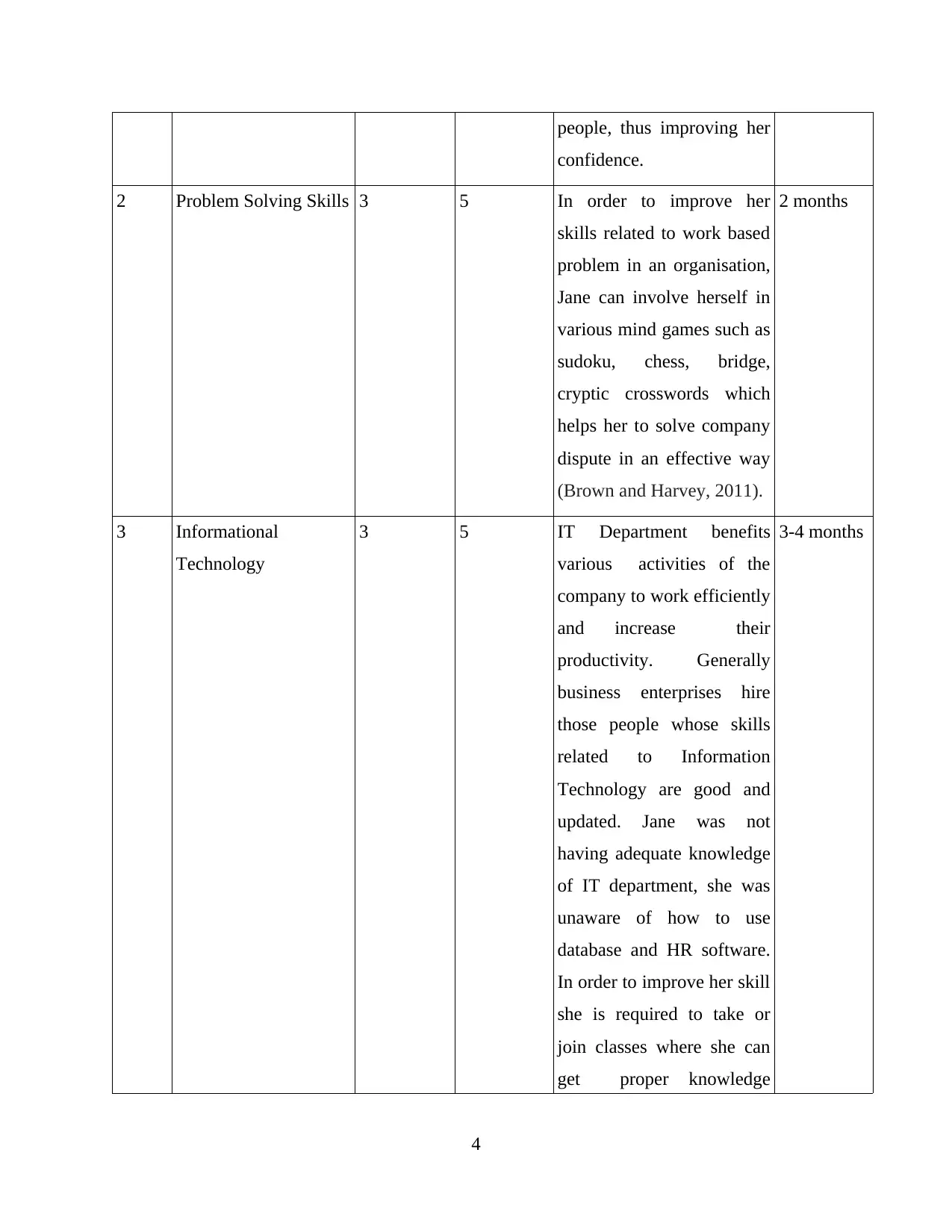
people, thus improving her
confidence.
2 Problem Solving Skills 3 5 In order to improve her
skills related to work based
problem in an organisation,
Jane can involve herself in
various mind games such as
sudoku, chess, bridge,
cryptic crosswords which
helps her to solve company
dispute in an effective way
(Brown and Harvey, 2011).
2 months
3 Informational
Technology
3 5 IT Department benefits
various activities of the
company to work efficiently
and increase their
productivity. Generally
business enterprises hire
those people whose skills
related to Information
Technology are good and
updated. Jane was not
having adequate knowledge
of IT department, she was
unaware of how to use
database and HR software.
In order to improve her skill
she is required to take or
join classes where she can
get proper knowledge
3-4 months
4
confidence.
2 Problem Solving Skills 3 5 In order to improve her
skills related to work based
problem in an organisation,
Jane can involve herself in
various mind games such as
sudoku, chess, bridge,
cryptic crosswords which
helps her to solve company
dispute in an effective way
(Brown and Harvey, 2011).
2 months
3 Informational
Technology
3 5 IT Department benefits
various activities of the
company to work efficiently
and increase their
productivity. Generally
business enterprises hire
those people whose skills
related to Information
Technology are good and
updated. Jane was not
having adequate knowledge
of IT department, she was
unaware of how to use
database and HR software.
In order to improve her skill
she is required to take or
join classes where she can
get proper knowledge
3-4 months
4
⊘ This is a preview!⊘
Do you want full access?
Subscribe today to unlock all pages.

Trusted by 1+ million students worldwide
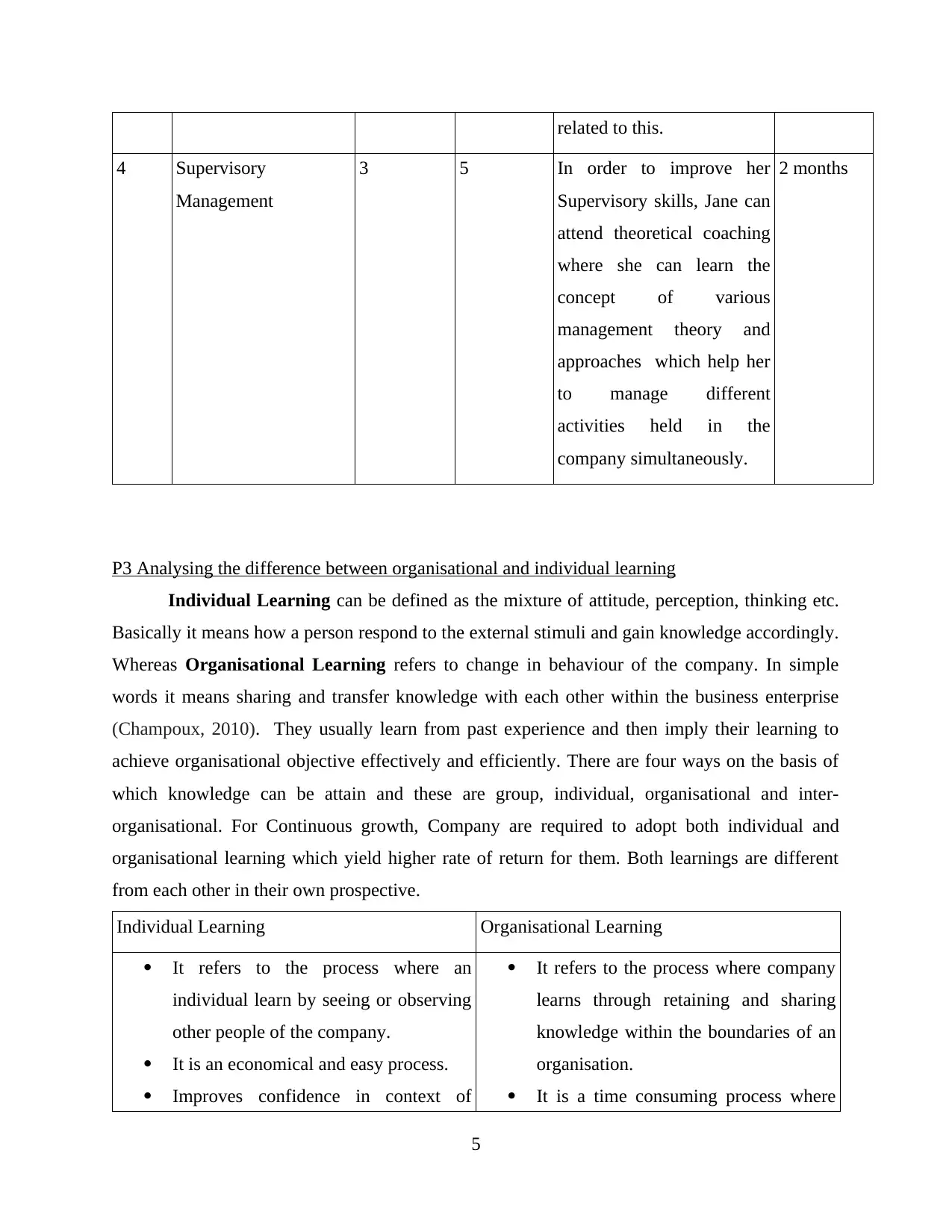
related to this.
4 Supervisory
Management
3 5 In order to improve her
Supervisory skills, Jane can
attend theoretical coaching
where she can learn the
concept of various
management theory and
approaches which help her
to manage different
activities held in the
company simultaneously.
2 months
P3 Analysing the difference between organisational and individual learning
Individual Learning can be defined as the mixture of attitude, perception, thinking etc.
Basically it means how a person respond to the external stimuli and gain knowledge accordingly.
Whereas Organisational Learning refers to change in behaviour of the company. In simple
words it means sharing and transfer knowledge with each other within the business enterprise
(Champoux, 2010). They usually learn from past experience and then imply their learning to
achieve organisational objective effectively and efficiently. There are four ways on the basis of
which knowledge can be attain and these are group, individual, organisational and inter-
organisational. For Continuous growth, Company are required to adopt both individual and
organisational learning which yield higher rate of return for them. Both learnings are different
from each other in their own prospective.
Individual Learning Organisational Learning
It refers to the process where an
individual learn by seeing or observing
other people of the company.
It is an economical and easy process.
Improves confidence in context of
It refers to the process where company
learns through retaining and sharing
knowledge within the boundaries of an
organisation.
It is a time consuming process where
5
4 Supervisory
Management
3 5 In order to improve her
Supervisory skills, Jane can
attend theoretical coaching
where she can learn the
concept of various
management theory and
approaches which help her
to manage different
activities held in the
company simultaneously.
2 months
P3 Analysing the difference between organisational and individual learning
Individual Learning can be defined as the mixture of attitude, perception, thinking etc.
Basically it means how a person respond to the external stimuli and gain knowledge accordingly.
Whereas Organisational Learning refers to change in behaviour of the company. In simple
words it means sharing and transfer knowledge with each other within the business enterprise
(Champoux, 2010). They usually learn from past experience and then imply their learning to
achieve organisational objective effectively and efficiently. There are four ways on the basis of
which knowledge can be attain and these are group, individual, organisational and inter-
organisational. For Continuous growth, Company are required to adopt both individual and
organisational learning which yield higher rate of return for them. Both learnings are different
from each other in their own prospective.
Individual Learning Organisational Learning
It refers to the process where an
individual learn by seeing or observing
other people of the company.
It is an economical and easy process.
Improves confidence in context of
It refers to the process where company
learns through retaining and sharing
knowledge within the boundaries of an
organisation.
It is a time consuming process where
5
Paraphrase This Document
Need a fresh take? Get an instant paraphrase of this document with our AI Paraphraser
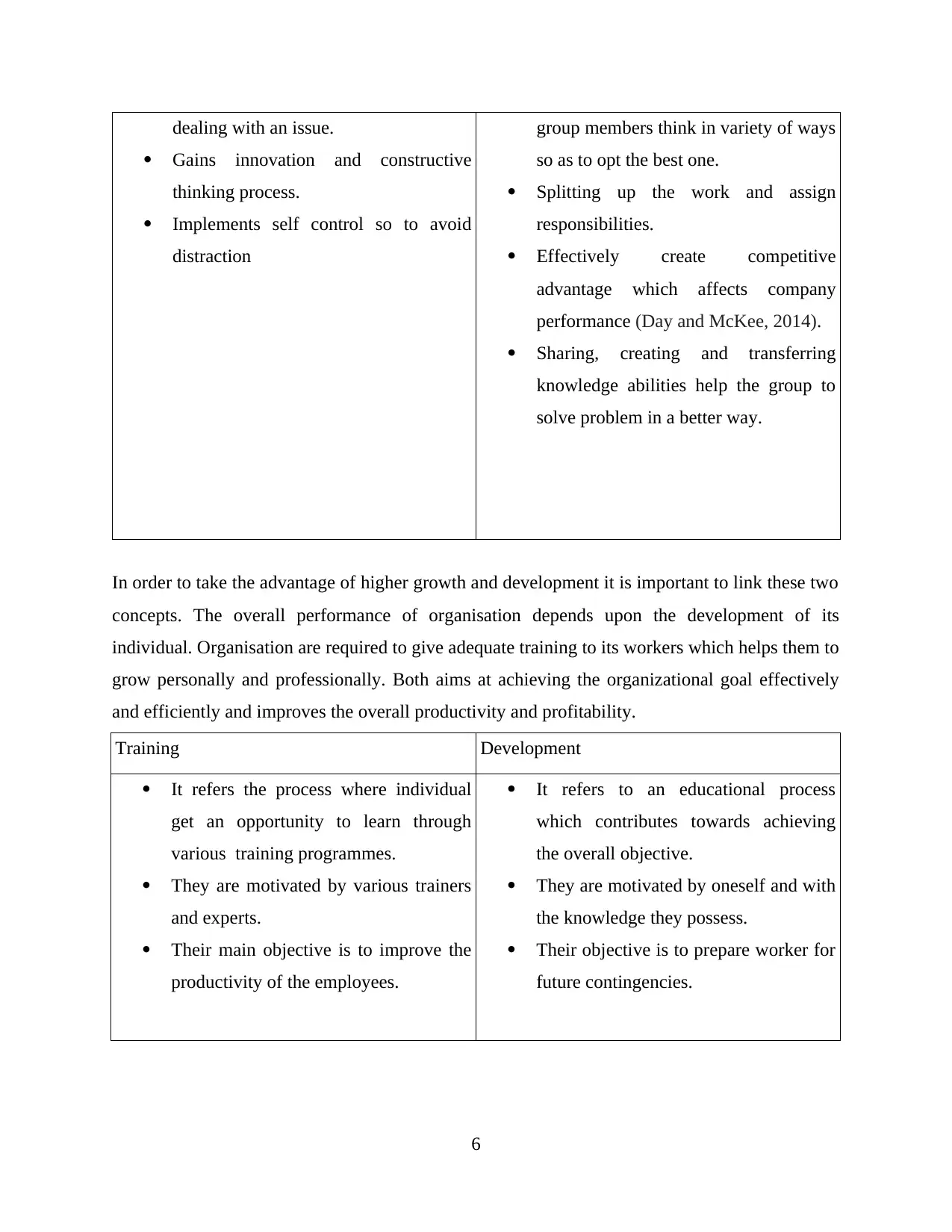
dealing with an issue.
Gains innovation and constructive
thinking process.
Implements self control so to avoid
distraction
group members think in variety of ways
so as to opt the best one.
Splitting up the work and assign
responsibilities.
Effectively create competitive
advantage which affects company
performance (Day and McKee, 2014).
Sharing, creating and transferring
knowledge abilities help the group to
solve problem in a better way.
In order to take the advantage of higher growth and development it is important to link these two
concepts. The overall performance of organisation depends upon the development of its
individual. Organisation are required to give adequate training to its workers which helps them to
grow personally and professionally. Both aims at achieving the organizational goal effectively
and efficiently and improves the overall productivity and profitability.
Training Development
It refers the process where individual
get an opportunity to learn through
various training programmes.
They are motivated by various trainers
and experts.
Their main objective is to improve the
productivity of the employees.
It refers to an educational process
which contributes towards achieving
the overall objective.
They are motivated by oneself and with
the knowledge they possess.
Their objective is to prepare worker for
future contingencies.
6
Gains innovation and constructive
thinking process.
Implements self control so to avoid
distraction
group members think in variety of ways
so as to opt the best one.
Splitting up the work and assign
responsibilities.
Effectively create competitive
advantage which affects company
performance (Day and McKee, 2014).
Sharing, creating and transferring
knowledge abilities help the group to
solve problem in a better way.
In order to take the advantage of higher growth and development it is important to link these two
concepts. The overall performance of organisation depends upon the development of its
individual. Organisation are required to give adequate training to its workers which helps them to
grow personally and professionally. Both aims at achieving the organizational goal effectively
and efficiently and improves the overall productivity and profitability.
Training Development
It refers the process where individual
get an opportunity to learn through
various training programmes.
They are motivated by various trainers
and experts.
Their main objective is to improve the
productivity of the employees.
It refers to an educational process
which contributes towards achieving
the overall objective.
They are motivated by oneself and with
the knowledge they possess.
Their objective is to prepare worker for
future contingencies.
6
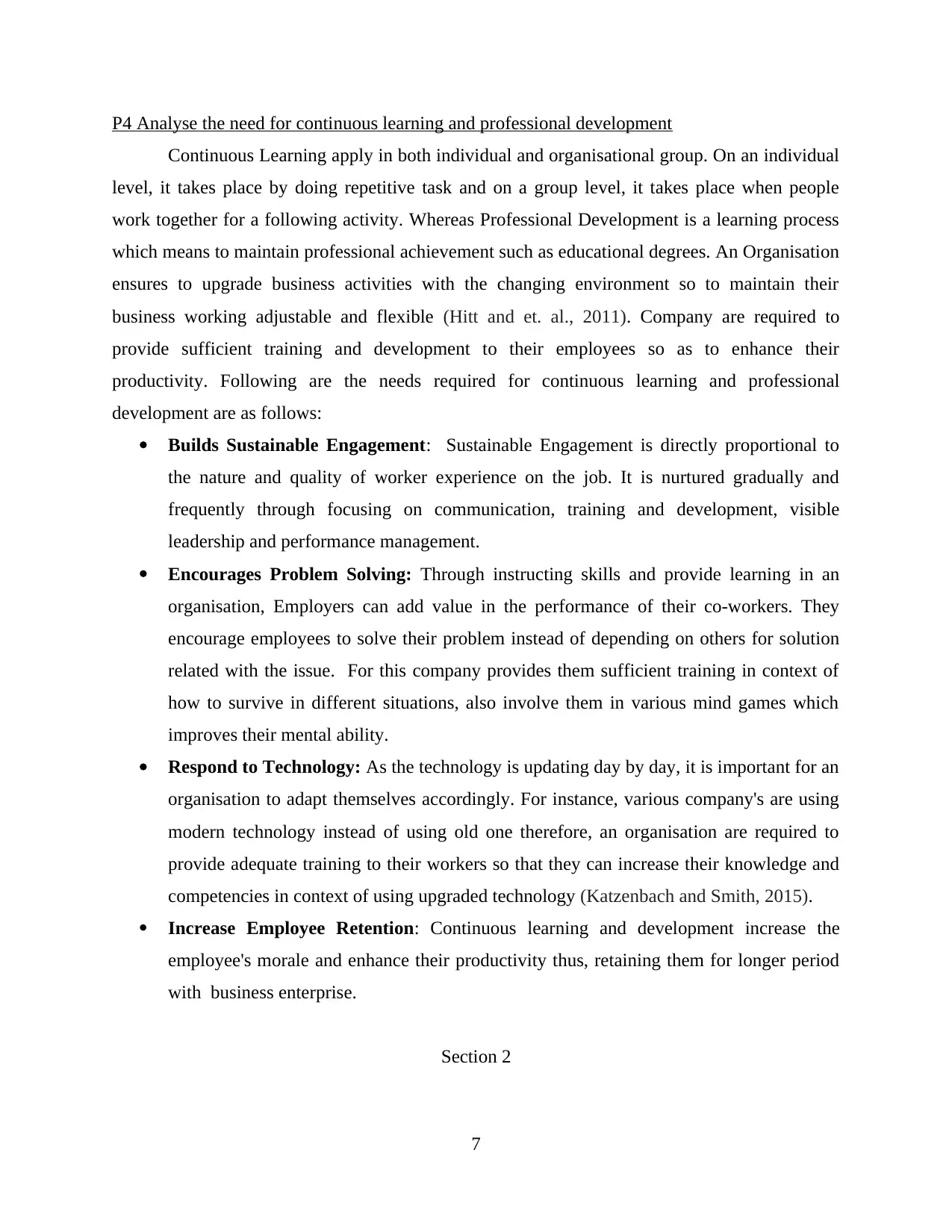
P4 Analyse the need for continuous learning and professional development
Continuous Learning apply in both individual and organisational group. On an individual
level, it takes place by doing repetitive task and on a group level, it takes place when people
work together for a following activity. Whereas Professional Development is a learning process
which means to maintain professional achievement such as educational degrees. An Organisation
ensures to upgrade business activities with the changing environment so to maintain their
business working adjustable and flexible (Hitt and et. al., 2011). Company are required to
provide sufficient training and development to their employees so as to enhance their
productivity. Following are the needs required for continuous learning and professional
development are as follows:
Builds Sustainable Engagement: Sustainable Engagement is directly proportional to
the nature and quality of worker experience on the job. It is nurtured gradually and
frequently through focusing on communication, training and development, visible
leadership and performance management.
Encourages Problem Solving: Through instructing skills and provide learning in an
organisation, Employers can add value in the performance of their co-workers. They
encourage employees to solve their problem instead of depending on others for solution
related with the issue. For this company provides them sufficient training in context of
how to survive in different situations, also involve them in various mind games which
improves their mental ability.
Respond to Technology: As the technology is updating day by day, it is important for an
organisation to adapt themselves accordingly. For instance, various company's are using
modern technology instead of using old one therefore, an organisation are required to
provide adequate training to their workers so that they can increase their knowledge and
competencies in context of using upgraded technology (Katzenbach and Smith, 2015).
Increase Employee Retention: Continuous learning and development increase the
employee's morale and enhance their productivity thus, retaining them for longer period
with business enterprise.
Section 2
7
Continuous Learning apply in both individual and organisational group. On an individual
level, it takes place by doing repetitive task and on a group level, it takes place when people
work together for a following activity. Whereas Professional Development is a learning process
which means to maintain professional achievement such as educational degrees. An Organisation
ensures to upgrade business activities with the changing environment so to maintain their
business working adjustable and flexible (Hitt and et. al., 2011). Company are required to
provide sufficient training and development to their employees so as to enhance their
productivity. Following are the needs required for continuous learning and professional
development are as follows:
Builds Sustainable Engagement: Sustainable Engagement is directly proportional to
the nature and quality of worker experience on the job. It is nurtured gradually and
frequently through focusing on communication, training and development, visible
leadership and performance management.
Encourages Problem Solving: Through instructing skills and provide learning in an
organisation, Employers can add value in the performance of their co-workers. They
encourage employees to solve their problem instead of depending on others for solution
related with the issue. For this company provides them sufficient training in context of
how to survive in different situations, also involve them in various mind games which
improves their mental ability.
Respond to Technology: As the technology is updating day by day, it is important for an
organisation to adapt themselves accordingly. For instance, various company's are using
modern technology instead of using old one therefore, an organisation are required to
provide adequate training to their workers so that they can increase their knowledge and
competencies in context of using upgraded technology (Katzenbach and Smith, 2015).
Increase Employee Retention: Continuous learning and development increase the
employee's morale and enhance their productivity thus, retaining them for longer period
with business enterprise.
Section 2
7
⊘ This is a preview!⊘
Do you want full access?
Subscribe today to unlock all pages.

Trusted by 1+ million students worldwide
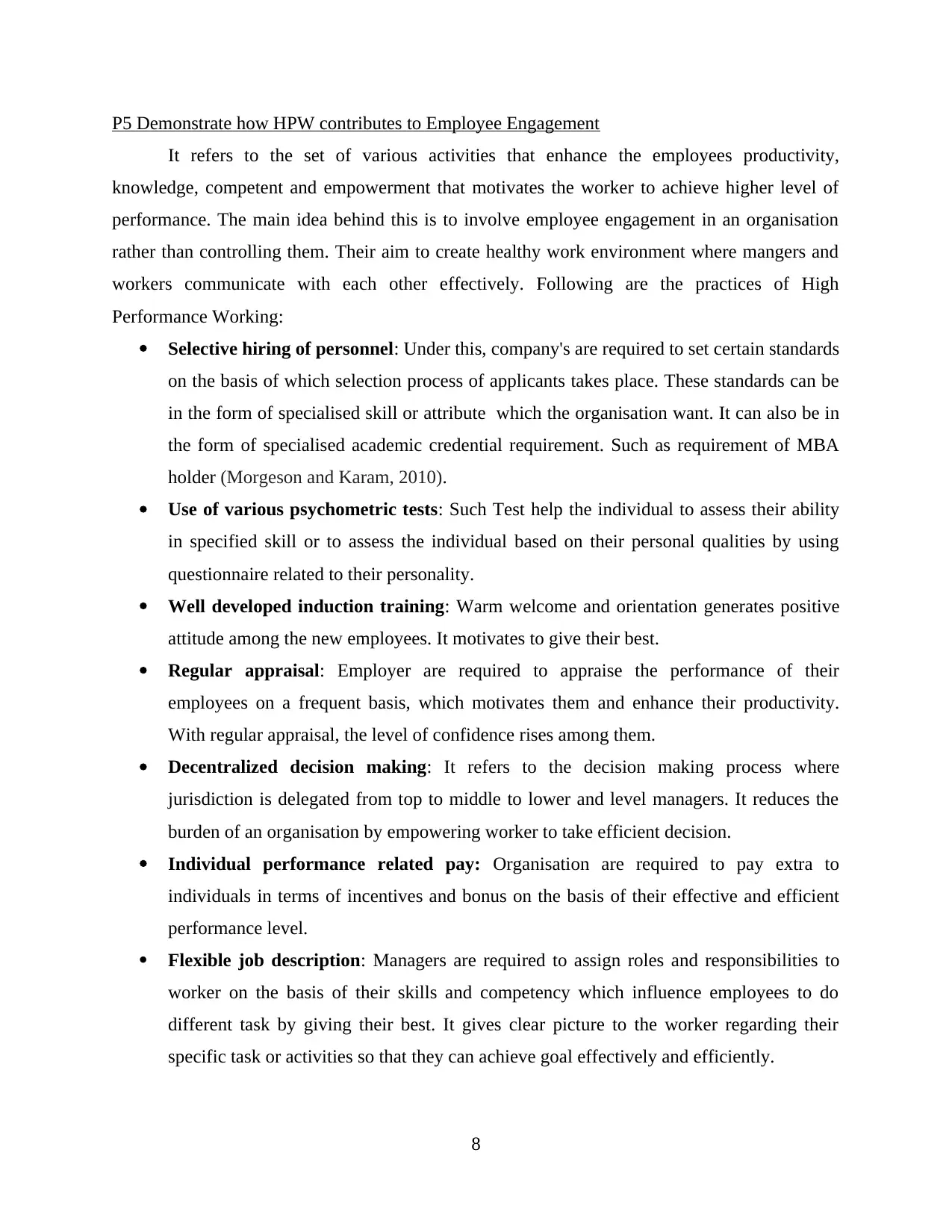
P5 Demonstrate how HPW contributes to Employee Engagement
It refers to the set of various activities that enhance the employees productivity,
knowledge, competent and empowerment that motivates the worker to achieve higher level of
performance. The main idea behind this is to involve employee engagement in an organisation
rather than controlling them. Their aim to create healthy work environment where mangers and
workers communicate with each other effectively. Following are the practices of High
Performance Working:
Selective hiring of personnel: Under this, company's are required to set certain standards
on the basis of which selection process of applicants takes place. These standards can be
in the form of specialised skill or attribute which the organisation want. It can also be in
the form of specialised academic credential requirement. Such as requirement of MBA
holder (Morgeson and Karam, 2010).
Use of various psychometric tests: Such Test help the individual to assess their ability
in specified skill or to assess the individual based on their personal qualities by using
questionnaire related to their personality.
Well developed induction training: Warm welcome and orientation generates positive
attitude among the new employees. It motivates to give their best.
Regular appraisal: Employer are required to appraise the performance of their
employees on a frequent basis, which motivates them and enhance their productivity.
With regular appraisal, the level of confidence rises among them.
Decentralized decision making: It refers to the decision making process where
jurisdiction is delegated from top to middle to lower and level managers. It reduces the
burden of an organisation by empowering worker to take efficient decision.
Individual performance related pay: Organisation are required to pay extra to
individuals in terms of incentives and bonus on the basis of their effective and efficient
performance level.
Flexible job description: Managers are required to assign roles and responsibilities to
worker on the basis of their skills and competency which influence employees to do
different task by giving their best. It gives clear picture to the worker regarding their
specific task or activities so that they can achieve goal effectively and efficiently.
8
It refers to the set of various activities that enhance the employees productivity,
knowledge, competent and empowerment that motivates the worker to achieve higher level of
performance. The main idea behind this is to involve employee engagement in an organisation
rather than controlling them. Their aim to create healthy work environment where mangers and
workers communicate with each other effectively. Following are the practices of High
Performance Working:
Selective hiring of personnel: Under this, company's are required to set certain standards
on the basis of which selection process of applicants takes place. These standards can be
in the form of specialised skill or attribute which the organisation want. It can also be in
the form of specialised academic credential requirement. Such as requirement of MBA
holder (Morgeson and Karam, 2010).
Use of various psychometric tests: Such Test help the individual to assess their ability
in specified skill or to assess the individual based on their personal qualities by using
questionnaire related to their personality.
Well developed induction training: Warm welcome and orientation generates positive
attitude among the new employees. It motivates to give their best.
Regular appraisal: Employer are required to appraise the performance of their
employees on a frequent basis, which motivates them and enhance their productivity.
With regular appraisal, the level of confidence rises among them.
Decentralized decision making: It refers to the decision making process where
jurisdiction is delegated from top to middle to lower and level managers. It reduces the
burden of an organisation by empowering worker to take efficient decision.
Individual performance related pay: Organisation are required to pay extra to
individuals in terms of incentives and bonus on the basis of their effective and efficient
performance level.
Flexible job description: Managers are required to assign roles and responsibilities to
worker on the basis of their skills and competency which influence employees to do
different task by giving their best. It gives clear picture to the worker regarding their
specific task or activities so that they can achieve goal effectively and efficiently.
8
Paraphrase This Document
Need a fresh take? Get an instant paraphrase of this document with our AI Paraphraser
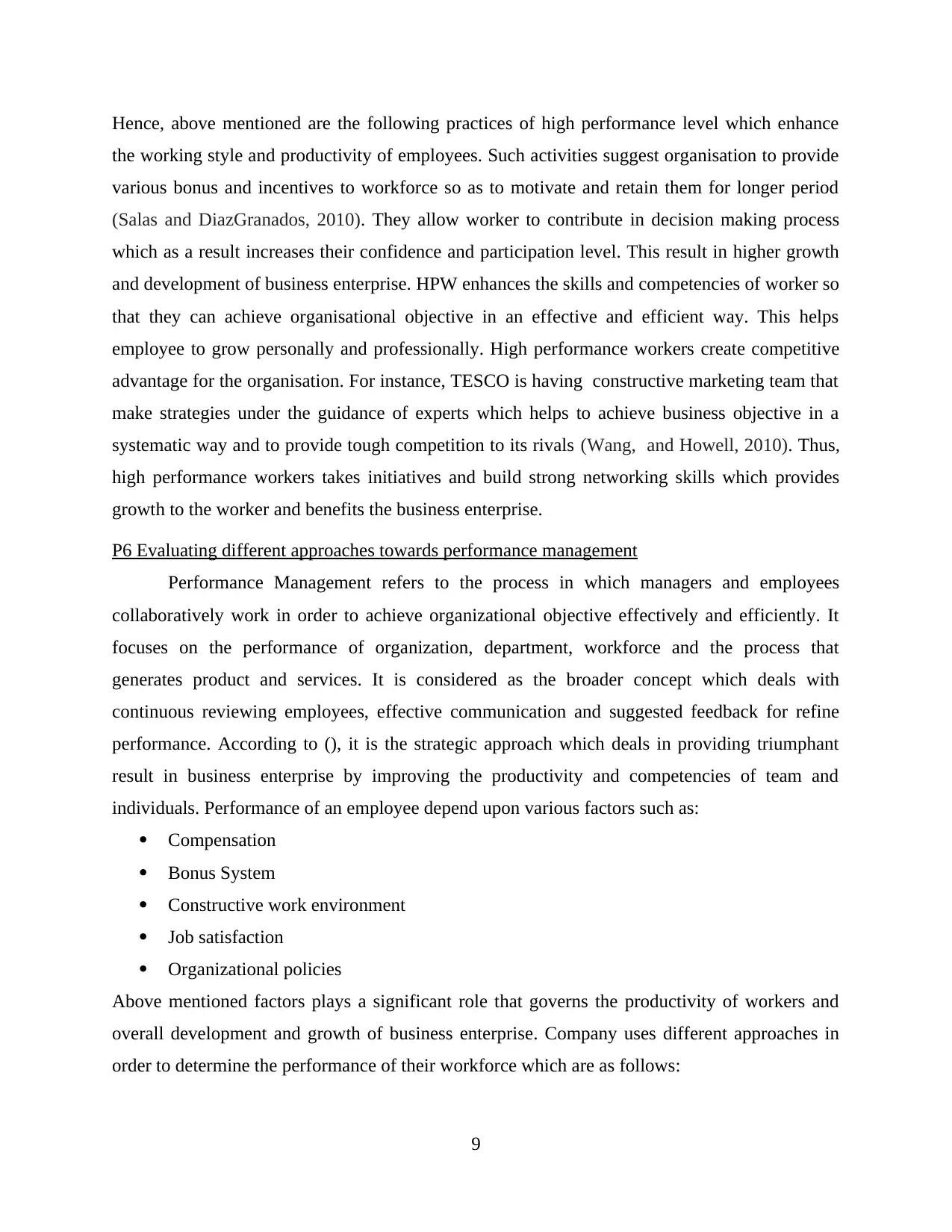
Hence, above mentioned are the following practices of high performance level which enhance
the working style and productivity of employees. Such activities suggest organisation to provide
various bonus and incentives to workforce so as to motivate and retain them for longer period
(Salas and DiazGranados, 2010). They allow worker to contribute in decision making process
which as a result increases their confidence and participation level. This result in higher growth
and development of business enterprise. HPW enhances the skills and competencies of worker so
that they can achieve organisational objective in an effective and efficient way. This helps
employee to grow personally and professionally. High performance workers create competitive
advantage for the organisation. For instance, TESCO is having constructive marketing team that
make strategies under the guidance of experts which helps to achieve business objective in a
systematic way and to provide tough competition to its rivals (Wang, and Howell, 2010). Thus,
high performance workers takes initiatives and build strong networking skills which provides
growth to the worker and benefits the business enterprise.
P6 Evaluating different approaches towards performance management
Performance Management refers to the process in which managers and employees
collaboratively work in order to achieve organizational objective effectively and efficiently. It
focuses on the performance of organization, department, workforce and the process that
generates product and services. It is considered as the broader concept which deals with
continuous reviewing employees, effective communication and suggested feedback for refine
performance. According to (), it is the strategic approach which deals in providing triumphant
result in business enterprise by improving the productivity and competencies of team and
individuals. Performance of an employee depend upon various factors such as:
Compensation
Bonus System
Constructive work environment
Job satisfaction
Organizational policies
Above mentioned factors plays a significant role that governs the productivity of workers and
overall development and growth of business enterprise. Company uses different approaches in
order to determine the performance of their workforce which are as follows:
9
the working style and productivity of employees. Such activities suggest organisation to provide
various bonus and incentives to workforce so as to motivate and retain them for longer period
(Salas and DiazGranados, 2010). They allow worker to contribute in decision making process
which as a result increases their confidence and participation level. This result in higher growth
and development of business enterprise. HPW enhances the skills and competencies of worker so
that they can achieve organisational objective in an effective and efficient way. This helps
employee to grow personally and professionally. High performance workers create competitive
advantage for the organisation. For instance, TESCO is having constructive marketing team that
make strategies under the guidance of experts which helps to achieve business objective in a
systematic way and to provide tough competition to its rivals (Wang, and Howell, 2010). Thus,
high performance workers takes initiatives and build strong networking skills which provides
growth to the worker and benefits the business enterprise.
P6 Evaluating different approaches towards performance management
Performance Management refers to the process in which managers and employees
collaboratively work in order to achieve organizational objective effectively and efficiently. It
focuses on the performance of organization, department, workforce and the process that
generates product and services. It is considered as the broader concept which deals with
continuous reviewing employees, effective communication and suggested feedback for refine
performance. According to (), it is the strategic approach which deals in providing triumphant
result in business enterprise by improving the productivity and competencies of team and
individuals. Performance of an employee depend upon various factors such as:
Compensation
Bonus System
Constructive work environment
Job satisfaction
Organizational policies
Above mentioned factors plays a significant role that governs the productivity of workers and
overall development and growth of business enterprise. Company uses different approaches in
order to determine the performance of their workforce which are as follows:
9
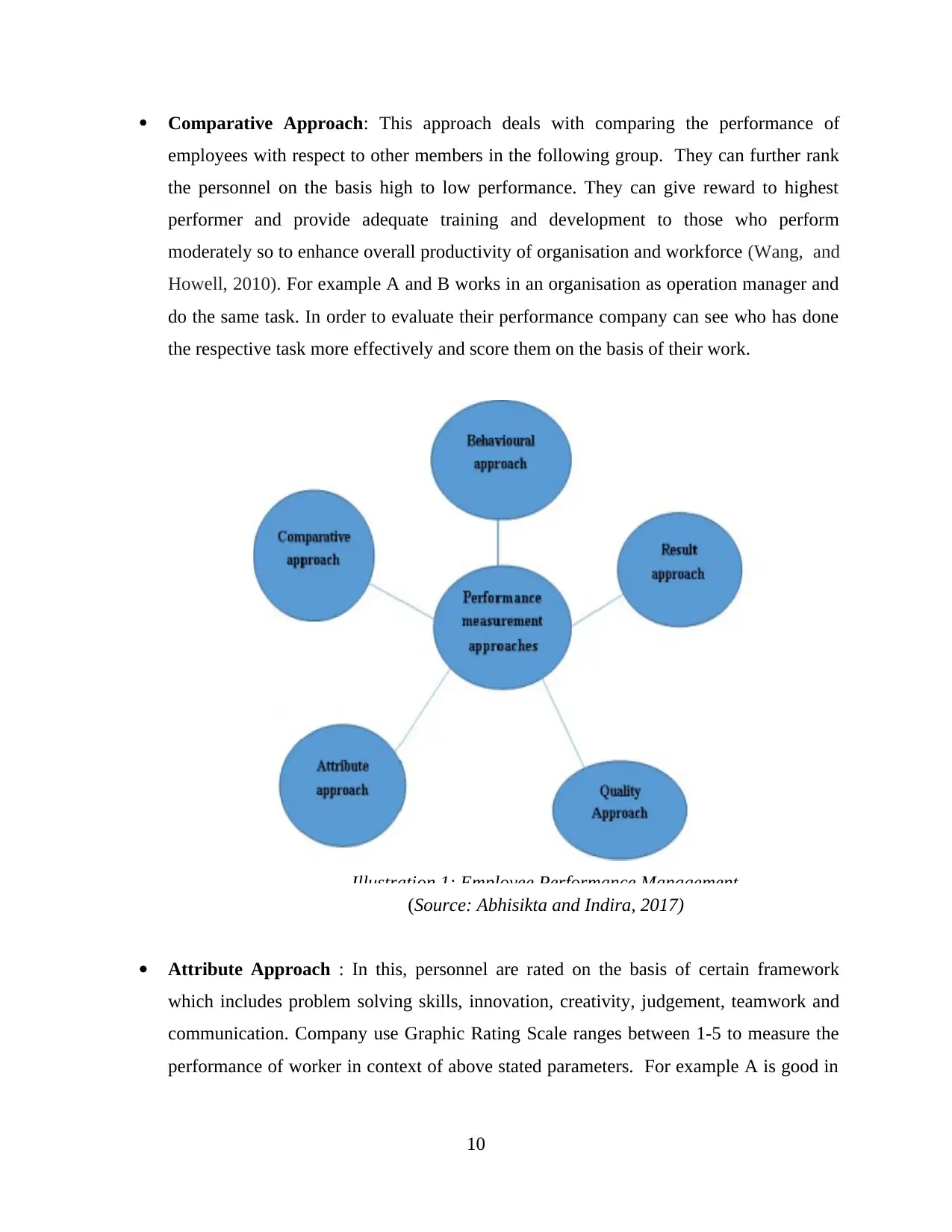
Comparative Approach: This approach deals with comparing the performance of
employees with respect to other members in the following group. They can further rank
the personnel on the basis high to low performance. They can give reward to highest
performer and provide adequate training and development to those who perform
moderately so to enhance overall productivity of organisation and workforce (Wang, and
Howell, 2010). For example A and B works in an organisation as operation manager and
do the same task. In order to evaluate their performance company can see who has done
the respective task more effectively and score them on the basis of their work.
(Source: Abhisikta and Indira, 2017)
Attribute Approach : In this, personnel are rated on the basis of certain framework
which includes problem solving skills, innovation, creativity, judgement, teamwork and
communication. Company use Graphic Rating Scale ranges between 1-5 to measure the
performance of worker in context of above stated parameters. For example A is good in
10
Illustration 1: Employee Performance Management
employees with respect to other members in the following group. They can further rank
the personnel on the basis high to low performance. They can give reward to highest
performer and provide adequate training and development to those who perform
moderately so to enhance overall productivity of organisation and workforce (Wang, and
Howell, 2010). For example A and B works in an organisation as operation manager and
do the same task. In order to evaluate their performance company can see who has done
the respective task more effectively and score them on the basis of their work.
(Source: Abhisikta and Indira, 2017)
Attribute Approach : In this, personnel are rated on the basis of certain framework
which includes problem solving skills, innovation, creativity, judgement, teamwork and
communication. Company use Graphic Rating Scale ranges between 1-5 to measure the
performance of worker in context of above stated parameters. For example A is good in
10
Illustration 1: Employee Performance Management
⊘ This is a preview!⊘
Do you want full access?
Subscribe today to unlock all pages.

Trusted by 1+ million students worldwide
1 out of 14
Related Documents
Your All-in-One AI-Powered Toolkit for Academic Success.
+13062052269
info@desklib.com
Available 24*7 on WhatsApp / Email
![[object Object]](/_next/static/media/star-bottom.7253800d.svg)
Unlock your academic potential
Copyright © 2020–2025 A2Z Services. All Rights Reserved. Developed and managed by ZUCOL.





